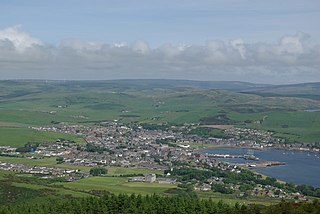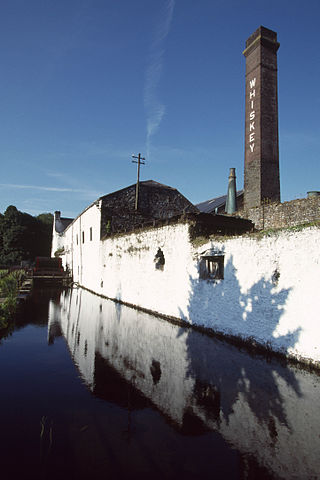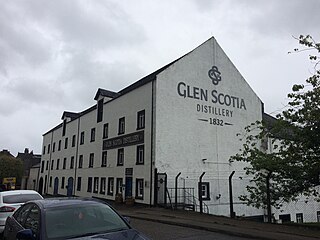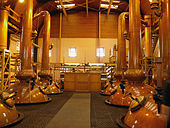
Scotch whisky, often simply called whisky or Scotch, is malt whisky or grain whisky made in Scotland.

Speyside single malts are single malt Scotch whiskies, distilled in Strathspey, the area around the River Spey in Moray and Badenoch and Strathspey, in northeastern Scotland.

The Crinan Canal is a nine miles (14 km) long navigable canal in Argyll and Bute, west of Scotland. It opened in 1801 and connects the village of Ardrishaig on Loch Gilp with Crinan on the Sound of Jura, providing a navigable route between the Firth of Clyde and the Inner Hebrides, without the need for a long diversion around the Kintyre Peninsula, and in particular the exposed Mull of Kintyre.

Campbeltown is a town and former royal burgh in Argyll and Bute, Scotland. It lies by Campbeltown Loch on the Kintyre Peninsula. Campbeltown became an important centre for Scotch whisky, and a busy fishing port.

Ardrishaig is a coastal village on Loch Gilp, at the southern (eastern) entrance to the Crinan Canal in Argyll and Bute in the west of Scotland. It lies immediately to the south of Lochgilphead, with the nearest larger town being Oban.

Bruichladdich Distillery is a distillery on the Rhinns of the isle of Islay in Scotland. The distillery produces mainly single malt Scotch whisky and The Botanist gin. Originally established in 1881 but closed many times throughout its history, its current form was opened in 2001. It has been owned by Rémy Cointreau since 2012.

Campbeltown single malts are single malt Scotch whiskies distilled in the burgh of Campbeltown, on the Kintyre peninsula in Scotland. Once a major producer of whisky with as many as 30 distilleries, and claiming the title "whisky capital of the world", its production has markedly declined. Most of the distilleries have gone out of business and little trace of them remains. The reason for this decline was that the town was "churning out whisky in volume ... with little concern for quality", according to a 2018 book that covers the entire industry and its history.

Springbank distillery is a family-owned single malt whisky distillery on the Kintyre Peninsula in western Scotland.

Lowland single malts are single malt whiskies distilled in Scotland's lowlands. The region is home to distilleries such as: Annandale Distillery in Annan; Auchentoshan near Clydebank; Bladnoch in Galloway; Daftmill in Fife; The Girvan Distilleries near Girvan; and Glenkinchie distillery near Edinburgh.
McClelland's Single Malt is a range of single malt Scotch whiskies from four of Scotland's key whisky distilling regions—Highland, Islay, Speyside and Lowland.
Hazelburn distillery was Campbeltown single malt Scotch whisky distillery in Campbeltown, Scotland, which was in operation between approximately 1825 and 1925.

Bladnoch distillery is a Lowland single malt Scotch whisky distillery located at Bladnoch, near Wigtown, Dumfries and Galloway in south west Scotland.

Rosebank Distillery is a Lowland single malt Scotch whisky distillery situated in Camelon on the banks of the Forth and Clyde canal between Edinburgh and Glasgow.

Kilbeggan Distillery is an Irish whiskey distillery situated on the River Brosna in Kilbeggan, County Westmeath, Ireland established in 1757 and owned by Suntory Global Spirits, a subsidiary of Suntory Holdings of Osaka, Japan.

The Edrington Group Limited, trading as Edrington, is a privately owned international spirits company based in Glasgow, Scotland. It produces single malts such as The Macallan, Highland Park, The Glenrothes, Naked Malt, and The Famous Grouse blended Scotch whisky. The spirits portfolio also includes Noble Oak Bourbon of Independence, Kentucky, and Brugal, the leading golden rum in the Caribbean. It also owns shares in Wyoming Whiskey, an American whiskey made in Kirby, Wyoming, and No. 3 London Dry Gin.

Port Charlotte distillery is a inactive Islay single malt Scotch whisky distillery on the island of Islay, off the west coast of Scotland.

Tobermory distillery is an Island single malt Scotch whisky distillery located on the Hebridean island of Mull, Scotland in the town of Tobermory
Ballechin distillery was a Scotch whisky distillery. It operated between 1810 and 1927. It was one of seven original farm distilleries operating in Perthshire. Out of these seven, Edradour is the only one remaining.

Glenturret distillery is a Highland single malt Scotch whisky distillery located two miles northwest of Crieff in Perthshire, Scotland on the banks of the Turret River.

Glen Scotia distillery or sometimes affectionately known as The Scotia or Old Scotia is a distillery that is a producer of single malt Scotch whisky. The distillery was founded in 1832 and is one of just three distilleries left in Campbeltown, the smallest whisky region.
















